Plot
Some time a little over 10,000 years from now, a noblewoman gives birth to a deformed child, a consequence of having been accidentally exposed to radiation from one of the temples of the Atom Gods. The baby is kept alive because one of the atom priests wants to conduct an experiment to see what will happen if the boy, unlike other mutant children, is given the full education of an atom priest.
In his teens the mutant boy Clane helps his father win a war with Mars. He also continues his studies while his grandfather, who is Lord Leader, and his tutors protect him from the Machiavellian intrigues swirling around him, especially those of his grandmother Lydia.
Reaching his majority, Clane turns his estate into a laboratory where he can test new inventions and machines that he has retrieved from the ruins of ancient cities and reactivated. When his grandfather dies, Clane becomes a target for assassination, but shortly thereafter Lady Lydia receives a vase containing the assassin’s ashes. Even a direct frontal assault by a militia fails against Clane and Lady Lydia is compelled to cease her attacks on him.
A war between the Linnan Empire and rebels on Venus provides an opportunity for Clane to take an expedition to explore the ruins of an ancient city there. When the Venusians capture the Lord Advisor and thousands of his troops and prepare to hang them, Clane appears in their camp and displays the awesome power of the Atom Gods. With the war won, Clane returns to Earth with his findings.
In spite of Clane’s warnings, the Linnan Empire is taken by surprise by an invasion of barbarians from Europa, the largest of Jupiter’s moons. The invaders kill the Lord Advisor and Clane must take command of the imperial forces. Disguised as a slave, Clane sneaks into his townhouse in the city of Linn and touches an artifact that he found on Venus. With the power it gives him he compels the barbarian chieftain, Czinczar, to surrender, but not before Czinczar shows him the body of an alien, one of a species that Czinczar believes caused the cataclysm that devastated human civilization thousands of years before. The Europan threat is vanquished, but now Clane has a new worry.
The story continues and concludes in The Wizard of Linn .

Alfred Elton van Vogt was an American science fiction writer. His fragmented, bizarre narrative style influenced later science fiction writers, notably Philip K. Dick. He was one of the most popular and influential practitioners of science fiction in the mid-twentieth century, the genre's so-called Golden Age, and one of the most complex. The Science Fiction Writers of America named him their 14th Grand Master in 1995.

Murray Leinster was a pen name of William Fitzgerald Jenkins, an American writer of genre fiction, particularly of science fiction. He wrote and published more than 1,500 short stories and articles, 14 movie scripts, and hundreds of radio scripts and television plays.
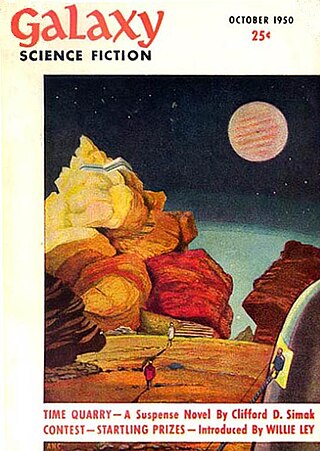
Galaxy Science Fiction was an American digest-size science fiction magazine, published in Boston from 1950 to 1980. It was founded by a French-Italian company, World Editions, which was looking to break into the American market. World Editions hired as editor H. L. Gold, who rapidly made Galaxy the leading science fiction magazine of its time, focusing on stories about social issues rather than technology.
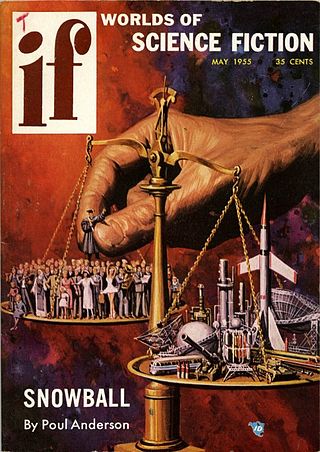
If was an American science fiction magazine launched in March 1952 by Quinn Publications, owned by James L. Quinn.

Lester del Rey was an American science fiction author and editor. He was the author of many books in the juvenile Winston Science Fiction series, and the editor at Del Rey Books, the fantasy and science fiction imprint of Ballantine Books, along with his fourth wife Judy-Lynn del Rey.

Unknown was an American pulp fantasy fiction magazine, published from 1939 to 1943 by Street & Smith, and edited by John W. Campbell. Unknown was a companion to Street & Smith's science fiction pulp, Astounding Science Fiction, which was also edited by Campbell at the time; many authors and illustrators contributed to both magazines. The leading fantasy magazine in the 1930s was Weird Tales, which focused on shock and horror. Campbell wanted to publish a fantasy magazine with more finesse and humor than Weird Tales, and put his plans into action when Eric Frank Russell sent him the manuscript of his novel Sinister Barrier, about aliens who own the human race. Unknown's first issue appeared in March 1939; in addition to Sinister Barrier, it included H. L. Gold's "Trouble With Water", a humorous fantasy about a New Yorker who meets a water gnome. Gold's story was the first of many in Unknown to combine commonplace reality with the fantastic.

Slan is a science fiction novel by American-Canadian writer A. E. van Vogt, as well as the name of the fictional race of superbeings featured in the novel. The novel was originally serialized in the magazine Astounding Science Fiction. It was subsequently published in hardcover in 1946 by Arkham House, in an edition of 4,051 copies. In 2016, Slan was awarded the Retro-Hugo Award for Best Novel for 1941.

The planet Venus has been used as a setting in fiction since before the 19th century. Its opaque cloud cover gave science fiction writers free rein to speculate on conditions at its surface—a "cosmic Rorschach test", in the words of science fiction author Stephen L. Gillett. The planet was often depicted as warmer than Earth but still habitable by humans. Depictions of Venus as a lush, verdant paradise, an oceanic planet, or fetid swampland, often inhabited by dinosaur-like beasts or other monsters, became common in early pulp science fiction, particularly between the 1930s and 1950s. Some other stories portrayed it as a desert, or invented more exotic settings. The absence of a common vision resulted in Venus not developing a coherent fictional mythology, in contrast to the image of Mars in fiction.
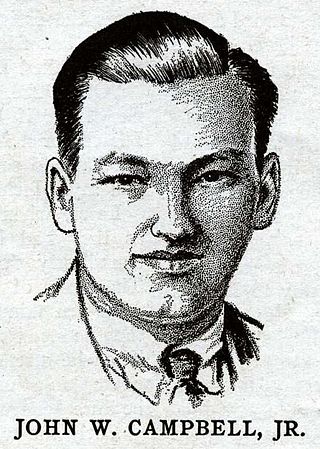
This is a bibliography of works by American writer John W. Campbell Jr.

Far Boundaries is an anthology of science fiction stories edited by American writer and anthologist August Derleth. It was first published by Pellegrini & Cudahy in 1951. Many of the stories had originally appeared in the magazines Variety, Dublin Literary Magazine, Knight’s Quarterly Magazine, Scribner's, Astounding Stories, The Arkham Sampler, Planet Stories, Super Science Stories, Thrilling Wonder Stories, Startling Stories, The Magazine of Fantasy & Science Fiction, Blue Book and Galaxy.

The Outer Reaches is an anthology of science fiction stories edited by August Derleth. It was first published by Pellegrini & Cudahy in 1951. The stories had originally appeared in the magazines Fantasy & Science Fiction, Astounding Stories, Blue Book, Maclean's, Worlds Beyond, Amazing Stories, Fantastic Adventures, Thrilling Wonder Stories and Galaxy Science Fiction or in the anthology Invasion from Mars.
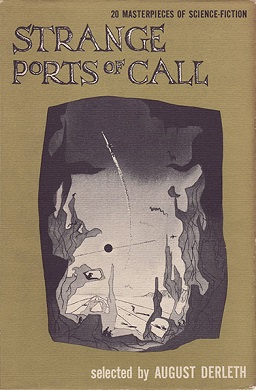
Strange Ports of Call is an anthology of science fiction stories edited by American writer August Derleth. It was first published by Pellegrini & Cudahy in 1948. The stories had originally appeared in the magazines Blue Book, Amazing Stories, Weird Tales, Science and Invention, Astounding Stories, Coronet, The New Review, The Black Cat, Thrilling Wonder Stories, Wonder Stories, Comet, The Saturday Evening Post, Collier's Weekly and Planet Stories.
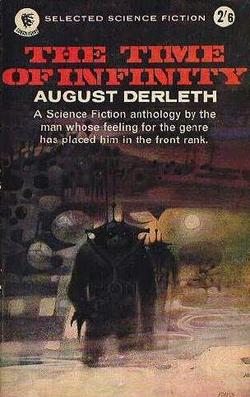
The Time of Infinity is an anthology of science fiction stories edited by American writer August Derleth. It was first published by Consul in 1963 and collects nine stories from Derleth's earlier anthology The Outer Reaches. The stories had originally appeared in the magazines Fantastic Adventures, Astounding Stories, Thrilling Wonder Stories, Galaxy Science Fiction and Amazing Stories or in the anthology Invasion from Mars edited by Orson Welles.

The Survivors is a science fiction novel by American writer Tom Godwin. It was published in 1958 by Gnome Press in an edition of 5,000 copies, of which 1,084 were never bound. The novel was published in paperback by Pyramid Books in 1960 under the title Space Prison. The novel is an expansion of Godwin's story "Too Soon to Die" which first appeared in the magazine Venture.

The Blind Spot is a science fiction novel by American writers Austin Hall and Homer Eon Flint. The novel was originally serialized in six parts in the magazine Argosy beginning in May 1921. It was first published in book form in 1951 by Prime Press in an edition of 74,200 copies, though fewer than 800 were actually bound, and the remainder are assumed lost. The sequel, The Spot of Life, was written by Hall alone.
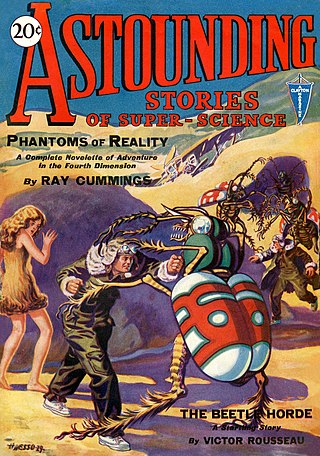
Analog Science Fiction and Fact is an American science fiction magazine published under various titles since 1930. Originally titled Astounding Stories of Super-Science, the first issue was dated January 1930, published by William Clayton, and edited by Harry Bates. Clayton went bankrupt in 1933 and the magazine was sold to Street & Smith. The new editor was F. Orlin Tremaine, who soon made Astounding the leading magazine in the nascent pulp science fiction field, publishing well-regarded stories such as Jack Williamson's Legion of Space and John W. Campbell's "Twilight". At the end of 1937, Campbell took over editorial duties under Tremaine's supervision, and the following year Tremaine was let go, giving Campbell more independence. Over the next few years Campbell published many stories that became classics in the field, including Isaac Asimov's Foundation series, A. E. van Vogt's Slan, and several novels and stories by Robert A. Heinlein. The period beginning with Campbell's editorship is often referred to as the Golden Age of Science Fiction.

The Wizard of Linn is a science fiction novel by American writer A. E. van Vogt, a sequel to Empire of the Atom. The novel was originally serialized in the science fiction magazine Astounding Science Fiction. It was first published in book form in Germany in 1961 by Terra Sonderband, as Der Zauberer von Linn.

Sentinels From Space is a science fiction novel by English writer Eric Frank Russell, first published in 1952 by American company Bouregy & Curl, Inc.. It was adapted from a story that appeared in the November 1951 issue of Startling Stories.
The year 1950 was marked, in science fiction, by the following events.

















